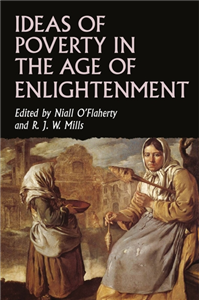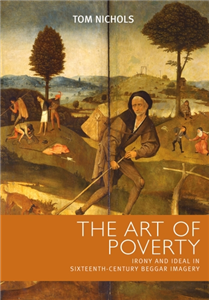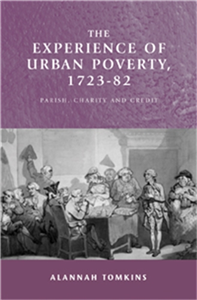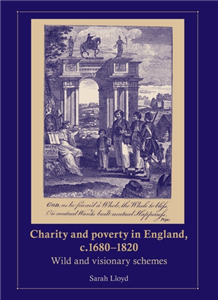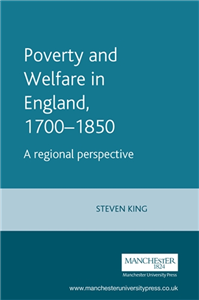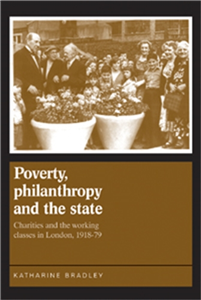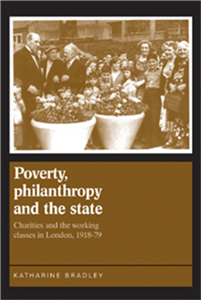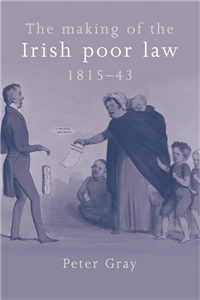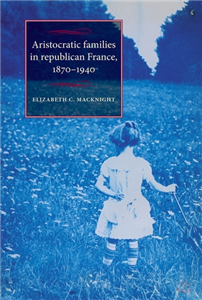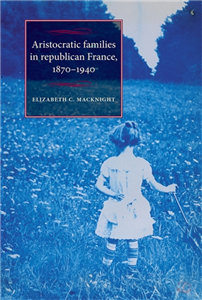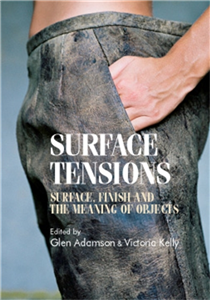Your Search Results
-
Promoted Content
-
Promoted ContentHumanities & Social SciencesApril 2024
Ideas of poverty in the Age of Enlightenment
by Niall O’Flaherty, Robin Mills
This collection of essays examines the ways in which poverty was conceptualised in the social, political, and religious discourses of eighteenth-century Europe. It brings together experts with a wide range of expertise to offer pathbreaking discussions of how eighteenth-century thinkers thought about the poor. Because the theme of poverty played important roles in many critical issues in European history, it was central to some of the key debates in Enlightenment political thought throughout the period, including the controversies about sovereignty and representation, public and private charity, as well as questions relating to crime and punishment. The book examines some of the most important contributions to these debates, while also ranging beyond the canonical Enlightenment thinkers, to investigate how poverty was conceptualised in the wider intellectual culture, as politicians, administrators and pamphlet writers grappled with the issue.
-
 Trusted Partner
The ArtsDecember 2007
Trusted Partner
The ArtsDecember 2007The art of poverty
Irony and ideal in sixteenth-century beggar imagery
by Tom Nichols
The art of poverty is the first book in English to analyse depictions of beggars in sixteenth-century European art. Featuring works from Germany, the Low Countries, Britain, France and Italy, it discusses a diverse body of imagery in many different media, from crude woodcuts to monumental church altarpieces. It develops a striking thesis, arguing that these works largely conformed to two paradoxical, though mutually supportive, representational approaches. The earlier chapters follow the emergence of a trenchantly negative approach in Northern art, in which beggars are shown as vagabonds, whose idleness and thievery threatened the values of sixteenth-century society (especially its growing emphasis on the need to work). In the other predominant visual mode, beggars are exalted as examples of sacred purity. In many Italian religious paintings, beggars are morally exalted with reference to sacred texts, and made formally beautiful with reference to revered artistic models. Though these approaches reflect the impact of religious reform, it is shown that, by the end of the century, they happily co-existed within Protestant and Catholic cultures. The final part of the book is concerned with the issue of artistic style and with the growing tendency of the beggar image to mediate and dissolve the didactic traditions through which it had originally been defined. The art of poverty will be of special interest to scholars and students of Renaissance art history, and its progressive approach and cross-disciplinary theme and perspective will also make it vital reading for those concerned with the development of early modern European culture. ;
-
 Trusted Partner
Humanities & Social SciencesOctober 2006
Trusted Partner
Humanities & Social SciencesOctober 2006The experience of urban poverty, 1723–82
Parish, charity and credit
by Alannah Tomkins
This comparative study of urban poverty is the first to chart the irregular pulse of poverty's encounters with officialdom. It exploits an unusual methodology to secure new perspectives from familiar sources. The highly localised characteristics of the welfare economy generated a peculiarly urban environment for the poor. Separate chapters examine the parameters of workhouse life when the preconceptions of contemporaries have been stripped away; the reach of institutional charities such as almshouses, schools and infirmaries; and the surprisingly broad clientele of urban pawnbrokers. Detailed analysis of the poor is achieved via meticulous matching of individuals who fell within the purview of two or more authorities. The result is a unique insight into the survival economics of urban poverty, arising not from a tidy network of welfare but from a loose assembly of options, where the impoverished positioned themselves repeatedly to fit official, philanthropic, or casual templates of the 'deserving'. This book will be essential reading for historians of English poverty and welfare, and eighteenth-century social and economic life. ;
-
 Trusted Partner
Humanities & Social SciencesDecember 2009
Trusted Partner
Humanities & Social SciencesDecember 2009Charity and poverty in England, c.1680–1820
Wild and visionary schemes
by Sarah Lloyd
This book explores responses to poverty in eighteenth-century England, with an eye to some of the odder manifestations of charity and poor relief. Whether discussing proposals for vast inland colonies or cosy firesides, men and women demonstrated that imagination, excitement and experiment were as important as systematic argument in making early-modern social policy. Ceremonies and material objects encapsulated ideas and attracted supporters; energy poured into realising imagined prospects in buildings, streetscapes and landscapes across England and beyond. Charity and Poverty in England aims to shed fresh light on ideas and lived experience, on cultural worlds in which social relations were unevenly worked out. It analyses the settings in which gentlemen, magistrates, officials, pamphleteers, ladies and neighbours reacted to the poverty of others, and poor people asserted their own beliefs and experiences. The book will be of interest to researchers in the fields of eighteenth-century cultural history and the history of social policy. ;
-
 Trusted Partner
Humanities & Social SciencesSeptember 2000
Trusted Partner
Humanities & Social SciencesSeptember 2000Poverty and Welfare in England, 1700–1850
A regional perspective
by Steve King
The first comprehensive and up-to-date overview of the literature on poverty, communal welfare systems and alternative welfare strategies. Offers a new perspective on how we should conceptualise poverty and how ordinary families and communities responded to that poverty.. Indicates the need for new directions in the study of poverty and welfare using previously unpublished results form one of the biggest poor law databases in existence.. Argues that welfare historians have paid too little attention to the complexities of defining and measuring poverty, and a variety of primary source material is used to reconsider the extent of poverty in the period 1700-1850.. Provides the first systematic attempt to discuss the regional dimensions of the welfare system in an English context. ;
-
 Trusted Partner
Humanities & Social SciencesAugust 2016
Trusted Partner
Humanities & Social SciencesAugust 2016Poverty, philanthropy and the state
Charities and the working classes in London, 1918–79
by Katharine Bradley
This book looks at a number of charities in London between 1918 and 1979, and the ways in which they negotiated the growth of the welfare state and changes in the communities around them.These charities - the 'university settlements'- were founded in the 1880's and 1890's and brought young graduates such as William Beveridge & Clement Attlee to deprived areas of cities to undertake social work. It is of interest to those who wish to know more about the complexities of the relationships between charities, the welfare state and individuals in the course of the twentieth century. Bradley argues that whilst the settlements often had difficulties in sustaining their work with the vulnerable, they remained an important factor between the individual and the impacts of poverty. Aimed at scholars in the fields of history, social policy, sociology and criminology this book will also be of interest to practitioners in the voluntary sector and government. ;
-
 Trusted Partner
First World WarNovember 2009
Trusted Partner
First World WarNovember 2009Poverty, philanthropy and the state
Charities and the working classes in London, 1918–79
by Katharine Bradley
This book looks at a number of charities in London between 1918 and 1979, and the ways in which they negotiated the growth of the welfare state and changes in the communities around them.These charities - the 'university settlements'- were founded in the 1880's and 1890's and brought young graduates such as William Beveridge & Clement Attlee to deprived areas of cities to undertake social work. It is of interest to those who wish to know more about the complexities of the relationships between charities, the welfare state and individuals in the course of the twentieth century. Bradley argues that whilst the settlements often had difficulties in sustaining their work with the vulnerable, they remained an important factor between the individual and the impacts of poverty. Aimed at scholars in the fields of history, social policy, sociology and criminology this book will also be of interest to practitioners in the voluntary sector and government.
-
 Trusted Partner
Humanities & Social SciencesMarch 2009
Trusted Partner
Humanities & Social SciencesMarch 2009The making of the Irish poor law, 1815–43
None
by Peter Gray
The making of the Irish poor law, 1815-43 examines the debates preceding and surrounding the 1838 act on the nature of Irish poverty and the responsibilities of society towards it. It traces the various campaigns for a poor law from the later eighteenth century. The nature and internal frictions of the great Irish poor inquiry of 1833-36 are analysed, along with the policy recommendations made by its chair, Archbishop Whately. It considers the aims and limitations of the government's measure and the public reaction to it in Ireland and Britain. Finally, it describes the implementation of the Poor Law between 1838 and 1843 under the controversial direction of George Nicholls. It will be of particular importance to those with a serious interest in the history of social welfare, of Irish social thought and politics, and of British governance in Ireland in the early nineteenth century. ;
-
 Trusted Partner
Humanities & Social SciencesJanuary 2017
Trusted Partner
Humanities & Social SciencesJanuary 2017Aristocratic families in republican France, 1870–1940
by Maire Cross, Elizabeth Chalmers MacKnight, David Hopkin
This is a study of the daily life, concerns, and dynamics of aristocratic families in the France of the Third Republic. Elizabeth Macknight draws on a vast range of material from private archives to contest assumptions about the irrelevancy of the nobility under the republican regime. Within a challenging political and economic environment nobles were determined to protect their interests and conserve the integrity of the aristocratic way of life. The convictions that underpinned nobles' responses to government initiatives emerge from the sources with freshness and clarity. Macknight interweaves male and female perspectives to provide a very full account of familial activities and decision-making with attention to all stages of the human lifecycle. Nobles' experiences of parenting and grandparenting, sibling and cousin relations, marriage, property negotiations, and interaction with servants are brought to light in a vivid and engaging narrative.
-
 Trusted Partner
Humanities & Social SciencesJanuary 2012
Trusted Partner
Humanities & Social SciencesJanuary 2012Aristocratic families in republican France, 1870–1940
by Maire Cross, Elizabeth C. Macknight, David Hopkin
This is a study of the daily life, concerns, and dynamics of aristocratic families in the France of the Third Republic. Elizabeth Macknight draws on a vast range of material from private archives to contest assumptions about the irrelevancy of the nobility under the republican regime. Within a challenging political and economic environment nobles were determined to protect their interests and conserve the integrity of the aristocratic way of life. The convictions that underpinned nobles' responses to government initiatives emerge from the sources with freshness and clarity. Macknight interweaves male and female perspectives to provide a very full account of familial activities and decision-making with attention to all stages of the human lifecycle. Nobles' experiences of parenting and grandparenting, sibling and cousin relations, marriage, property negotiations, and interaction with servants are brought to light in a vivid and engaging narrative. ;
-
 Trusted Partner
The ArtsNovember 2013
Trusted Partner
The ArtsNovember 2013Surface tensions
Surface, finish and the meaning of objects
by Christopher Breward, Glenn Adamson, Victoria Kelley, Bill Sherman
Surfaces are often held to be of lesser consequence than 'deeper' or more 'substantive' aspects of artworks and objects. Yet it is also possible to conceive of the surface in more positive terms: as a site where complex forces meet. Surfaces can be theorized as membranes, protective shells, sensitive skins, even thicknesses in their own right. The surface is not so much a barrier to content as an opportunity for encounter: in new objects, the surface is the site of qualities of finish, texture, the site of tactile interaction, the last point of contact between object and maker, and the first point of contact between object and user. Surface tensions includes sixteen essays that explore this theoretically uncharted terrain. The subjects range widely: domestic maintenance; avant-garde fashion; the faking of antiques; postmodern architecture and design; contemporary film costume. Of particular emphasis within the volume are textiles, which are among the most complex and culturally rich materialisations of surface. As a whole, the book provides insights into the whole lifecycle of objects, not just their condition when new. ;
-
 Trusted Partner
Humanities & Social SciencesJanuary 2019
Trusted Partner
Humanities & Social SciencesJanuary 2019Sickness, medical welfare and the English poor, 1750-1834
by Steven King, Keir Waddington, David Cantor
At the core of this book are three central contentions: That medical welfare became the totemic function of the Old Poor Law in its last few decades; that the poor themselves were able to negotiate this medical welfare rather than simply being subject to it; and that being doctored and institutionalised became part of the norm for the sick poor by the 1820s, in a way that had not been the case in the 1750s. Exploring the lives and medical experiences of the poor largely in their own words, Sickness, medical welfare and the English poor offers a comprehensive reinterpretation of the so-called crisis of the Old Poor Law from the later eighteenth century. The sick poor became an insistent presence in the lives of officials and parishes and the (largely positive) way that communities responded to their dire needs must cause us to rethink the role and character of the poor law.
-
 Trusted Partner
Humanities & Social SciencesMay 2020
Trusted Partner
Humanities & Social SciencesMay 2020Lawyers for the poor
Legal advice, voluntary action and citizenship in England, 1890–1990
by Katherine Bradley
From the 1890s onwards, social reformers, volunteer lawyers, and politicians increasingly came to see access to affordable or free legal advice as a critical part of helping working-class people uphold their rights with landlords, employers, and retailers - and, from the 1940s, with the welfare state. Whilst a state scheme was launched in 1949, it was never fully implemented and help from a lawyer remained out of the reach of many people. Lawyers for the poor is the first full-length study of the development of voluntary action and mutual schemes to make the law more accessible, and the pressure put on the legal profession and governments to bring in further reforms. It offers new insights of the role of access to the law in shaping ideas about citizenship and civil rights in the twentieth century.
-
 Trusted Partner
Trusted Partner
-
 Trusted Partner
March 2009
Trusted Partner
March 2009Hero und Leander
by Musaios, Marion Giebel, Marion Giebel
Hero, von den Eltern zur Priesterin bestimmt, lebt allein in Sestos am nördlichen Ufer der Dardanellen. Im gegenüberliegenden Abydos stürzt sich auf der asiatischen Seite Leander allnächtlich in die Fluten, um, geleitet von der Öllampe, die Hero ins Fenster ihres Wohnturms stellt, zu ihr zu gelangen – bis eines Nachts im Sturm die Flamme verlischt. Die Sage von den zwei Königskindern, die zusammen nicht kommen können, weil das Wasser viel zu tief ist, hat schon Ovid gestaltet, ihre vollendete Fassung, auf die sich auch Bearbeiter wie Schiller und Grillparzer beziehen, findet sich aber in dem Versepos des Musaios, der um 500 nach Christus lebte. In der neuen, eleganten Prosaübertragung von Marion Giebel wird dieser anrührende Text, mit bildnerischen Darstellungen des Mythos aus verschiedenen Zeiten sowie einem die geschichtlichen Zusammenhänge erläuternden Nachwort versehen, wieder auf deutsch zugänglich gemacht.
-
 Trusted Partner
September 2017
Trusted Partner
September 2017Product Lifecycle Management (PLM)
Kundennutzen durch integriertes Prozessmanagement
by Peschke, Friedrich / Herausgegeben von Kamiske, Gerd F.
-
 Trusted Partner
October 2021
Trusted Partner
October 2021Blessed & Broken. Die Kraft des Klangs
by Anne-Marie Jungwirth, Moon Notes
In Anne-Marie Jungwirths "Blessed & Broken" dreht sich alles um Livia, eine junge Frau mit einer besonderen Gabe, die es ihr ermöglicht, durch Klang und Schall Materie zu bewegen. Diese seltene Fähigkeit, die in ihrem Königreich Palente nur wenigen Frauen zuteilwird, bringt Livia jedoch in eine prekäre Lage, da ihr Vater die Nutzung dieser Kraft verbietet. Der Grund dafür ist tragisch: Ihre Mutter kam aufgrund dieser Gabe ums Leben. Als ihre Familie in Not gerät – der Vater verliert seine Bürgerrechte und Livias schwangere Schwester benötigt dringend eine Mitgift –, sieht Livia keine andere Wahl, als einen gefährlichen Pakt mit dem attraktiven Kriegsherrn Cristan einzugehen. Dieser Handel könnte die Rettung ihrer Familie bedeuten, doch er stellt Livias Prinzipien und ihre bisherige Lebensweise infrage. "Blessed & Broken" entführt die Leser in eine Welt voller Magie, in der Livia sich zwischen der Pflicht gegenüber ihrer Familie und dem Verbot ihres Vaters hin- und hergerissen fühlt. Ihre Entscheidung, sich Cristan anzuschließen, bringt sie nicht nur auf das Schlachtfeld, sondern zwingt sie auch, sich ihrer Gabe und deren Konsequenzen zu stellen. Im Verlauf der Geschichte entwickelt sich Livia zu einer mutigen und starken Protagonistin, die für ihre Ziele kämpft und dabei nie ihre Familie aus den Augen verliert. Die Romanze zwischen ihr und Cristan entwickelt sich langsam und ist geprägt von gegenseitigem Respekt und wachsendem Vertrauen, auch wenn diese Beziehung ihre Höhen und Tiefen hat. "Blessed & Broken" ist somit eine fesselnde Mischung aus Fantasy und Romantik, die die Leser mit ihrem einzigartigen Magiesystem und der starken Charakterentwicklung begeistert. Erlebe eine Welt, in der Frauen durch Klang und Schall Materie beherrschen können, eine seltene und faszinierende Gabe, die "Segnung" genannt wird. Begleite Livia, eine mutige und entschlossene junge Frau, die trotz familiärer Verbote und persönlicher Risiken ihre außergewöhnliche Gabe einsetzt, um ihre Familie zu retten. Spannung und Intrigen erwarten dich, als Livia einen Pakt mit dem attraktiven und mächtigen Kriegsherrn Cristan eingeht, der ihre Welt auf den Kopf stellt. Verfolge die sich langsam entwickelnde und komplexe romantische Beziehung zwischen Livia und Cristan, geprägt von gegenseitigem Respekt, Vertrauen und unerwarteten Gefühlen. Lass dich in das Königreich Palente entführen, eine atemberaubende Fantasy-Welt voller Magie, Geheimnisse und einer tiefgreifenden Geschichte, die durch einen detailreichen und bildgewaltigen Schreibstil zum Leben erweckt wird. Epische Schlachten und mutige Entscheidungen: Sei dabei, wenn Livia an der Seite Cristans in epische Schlachten zieht und dabei ihre eigene Kraft und ihren Mut entdeckt. Einzelband mit Suchtpotenzial: Genieße eine abgeschlossene Geschichte voller Spannung, Magie und Romantik, die dich von der ersten bis zur letzten Seite fesseln wird.
-
 Trusted Partner
Literature & Literary StudiesOctober 2012
Trusted Partner
Literature & Literary StudiesOctober 2012Narration in nineteenth-century French short fiction
Prosper Mérimée to Marcel Schwob
by Peter Cogman
The short fiction that flourished in nineteenth-century France has attracted relatively little critical attention compared with the novel. This study focuses on some key stories by major authors of contes and nouvelles from the late 1820s to the 1890s, taking as a starting-point, aspects of narrative technique as a way of exploring not just characteristic strategies of short fiction, but also the ends to which they were put: recurrent themes, and the vision of mankind. Each chapter looks in some detail at three or four stories, referring briefly to other tales for illustration. The underlying point that emerges from this study is that the interest of a tale lies in the telling, not the events. ;
-
 Trusted Partner
Trusted Partner




